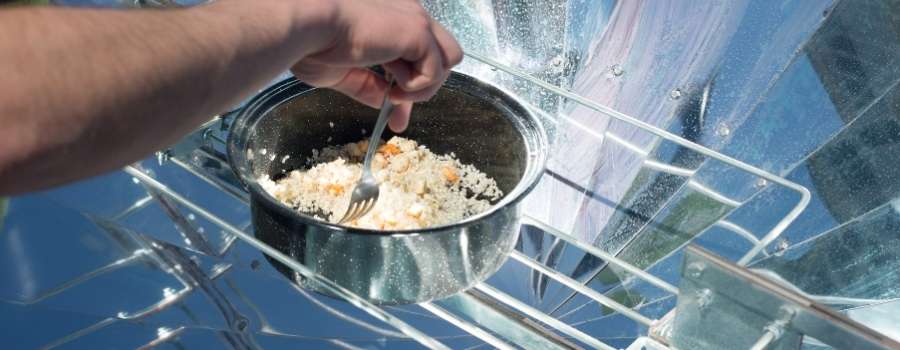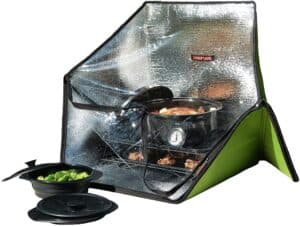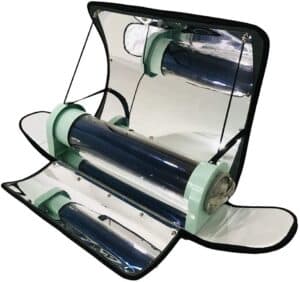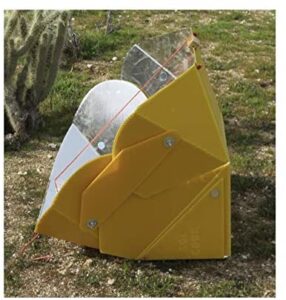
With the increasing adoption and popularity of solar energy, applications other than electricity generation are also capturing the imagination. One such appliance is the Solar Oven.
Interestingly, one can posit that but for some misconceptions about the limitations of these appliances, solar ovens would be even more popular.
Let us dive into the question of how effective solar ovens can be.
This article may contain affiliate links.
How Effective are Solar Ovens?
On average, solar ovens don’t tend to be highly effective, mainly due to their requirement of consistent sunlight for a long period of time.
Solar ovens are best used for cooking foods that can cook quickly and at low temperatures. I remember when I was a kid in Boy Scouts one of the leaders made a solar oven out of a box and tinfoil and attempted to bake a cake on one of our campouts…in the winter.
It did work, but ended up taking several hours and he had to make the cake in several thin layers so that they would cook evenly. The only negative ended up being trying to spread frozen frosting over warm cake…but hey, even shredded cake is delicious.
A solar oven’s design and efficiency is well appreciated by regular users, especially in countries where the sun is a significant presence, perhaps more so than power supplies that can be relied on on a day in, day out basis. Even in developed countries, off-grid or post-disaster uses make solar ovens a viable option.
How Do Solar Ovens Work?
Solar ovens work by using reflective surfaces to capture and concentrate sunlight, converting it into heat energy. The reflective material traps sunlight, creating a greenhouse effect inside the oven, raising the temperature for cooking without the need for traditional fuels or electricity.
A solar oven typically consists of a reflective material, such as aluminum or glass, which traps and concentrates sunlight, converting it into heat. This trapped heat creates a greenhouse effect inside the oven, raising the temperature and allowing for cooking without the need for conventional fuels or electricity.
The key component of a solar oven is its reflective surface, often referred to as the collector. This surface is strategically angled to capture and redirect the sunlight into the cooking chamber. The reflective material ensures that a significant amount of solar radiation is absorbed and focused, maximizing heat generation.
The cooking chamber of the solar oven is typically enclosed and insulated to trap the heat efficiently. It is made of materials that allow sunlight to penetrate, such as glass or plastic, while retaining the generated heat within the oven.
Solar ovens work on the principle of converting sunlight into heat energy. When sunlight strikes the reflective surface of the oven, it reflects and concentrates the rays onto the cooking vessel or food placed inside.
As the concentrated sunlight strikes the cooking vessel, the energy is converted into heat, gradually raising the temperature. The trapped heat circulates within the cooking chamber, cooking the food
How Hot can Solar Ovens Get?
Solar ovens can reach temperatures ranging from 200 to 350 degrees Fahrenheit (93 to 177 degrees Celsius), depending on factors such as sunlight intensity, design, and duration of exposure.
The temperature achieved inside a solar oven can vary depending on factors such as the intensity of sunlight, the design of the oven, and the duration of exposure.
Setting Realistic Expectations of Solar Ovens
As I’ll discuss in more detail below, solar ovens function very well under the right circumstances. However, there are some limitations that cannot be overcome in any meaningful way.
They require bright, lasting sunlight to perform at their peak, as opposed to overcast days or after sundown. Many models cannot produce high heating levels (though there are exceptions, such as parabolic designs with vacuum-sealed containers). Such ovens cannot produce edible food quickly.
Here are a few other key points to be aware of:
Seasonality
The best areas to use solar ovens should receive an average of 4+ kilowatt-hours of sunlight per square meter per day. For this reason, cooks living in the right areas of India and China make excellent use of solar cookers.
In North America, the best time to break out the solar cooker is the summer (April through September) unless you are too far north or south. Solar ovens can still be used in the winter unless conditions are completely overcast. But weaker sunlight levels will make cooking difficult and take longer.
Settings Tailormade for Solar Ovens
The times when solar ovens work to their fullest advantage is when the weather is amenable, as explained above. In tropical countries, or during the right season in the US and Europe, solar ovens are great for off-grid use or in the backyard. They are also used during periods of disaster relief or power failure. Finally, poor people – who may not have the money to afford power or fossil fuel – can benefit from using home-designed ovens.
Solar Ovens are Only Suitable for Certain Types of Foods
Items you could cook in a crockpot or slow cooker are appropriate for solar cookers. But there is one significant difference. Given that there is no source of external heat (electric, gas, fossil fuel, etc.) apart from the heat trapped within, you cannot open the cooking pot to stir. The food must be left alone for long periods of time, otherwise, you will let out the heat.
Solar ovens are best suited to functions such as baking, boiling, or roasting. Other common functions, such as frying, searing, and broiling will not be possible.
The Main Types Of Solar Ovens
As described below, solar ovens can be constructed utilizing a wide range of designs. Three types of specifications are as follows:
Box Ovens
The most popular design worldwide, the standard box oven has a relatively simple, box-like central vessel, surrounded by glass or plastic to trap the heat inside after reflector panels direct concentrated sunlight into the box. The size of the box may vary, making it possible to either cook individual dishes or to cook for a larger number of people. They are the perfect middle-class among solar ovens – not too fancy or expensive, and not the cheapest.
Box ovens are very popular in tropical countries such as those in South Asia.
Here in the states, box ovens are usually associated with camping and backpacking. A popular choice is this model by Sunflair, which is a great choice for backpackers due to its collapsible, lightweight design.
Parabolic Ovens
The parabolic oven has a more sophisticated design – it has curved walls which direct the heat to the oven’s base, making it easier to cook food at sustained high heat. The only problem is that depending on the design and the weather conditions, and the fact that the heating cannot be regulated, and that the temperature is hard to anticipate, cooking in parabolic ovens requires much more attention than some other types of solar ovens.
Given their high heating aimed towards the base of the surface where the food is being cooked, plus the skill and attention that cooks should possess, it is more common to use parabolic ovens for commercial, rather than residential or amateur, cooking purposes. They happen to be very popular in east and southeast Asia.
Seeing as a lot of the gear I mention throughout this site is designed to make camping and hiking more fun and “next level,” I thought I’d recommend another solar oven that’s designed to be portable and lightweight. For Parabolic Solar Ovens, I’d check out the ETE ETMATE Solar Cooker.
As I mentioned above, Parabolic Ovens tend to be more sophisticated in their design. The ETE ETMATE offers some of these more sophisticated features, namely the ability to heat to temperatures pushing 550 degrees F and cook times as quick as 15 minutes.
Panel Ovens
Panel ovens are cheap to manufacture and/or assemble. The design combines the principles behind box ovens and parabolic ovens. Panels are employed to direct heat into an insulated box or pot, where it is captured to help cook the food.
As mentioned below, other design tweaks can be incorporated into each of these types of ovens, depending on the use and the sophistication of the cook.
These tend to only reach temperatures of about 250 degrees F, so they are best suited for foods that need to cook “low and slow” or that just need to be warmed up.
For this style of solar oven, check out the All-Season Solar Cooker by SolCook. It’s another piece of gear that is designed with the camper in mind, though this style of solar cooker isn’t as ideal for backpacking.
These are my least favorite of the options, mainly because of the lack of heating capabilities of the Parabolic models and the portability of the box-style solar cookers.
Benefits Of Solar Ovens
In addition to the fact that the solar oven is genuinely fun to use, whether you treat it like a slow cooker or a somewhat novelty item at the outset, there are some real bottom line-driven benefits for those who use solar ovens.
Wide Range Of Designs
A solar oven can be designed very simply, with cardboard reflectors and a general cooking vessel within a plastic or glass casing in the middle. These ovens cannot sustain temperatures much higher than 250 degrees, but they do fine for a variety of functions including boiling water or cook food along the lines of a crockpot or slow cooker.
If, on the other hand, you decide to invest in a proper metal and plexiglass oven with high-end reflectors, the appliance will be capable of sustaining heat up to 400 degrees for longer periods of time, making them capable of more functions and precision cooking.
Subtle variations in design, such as investing in a low emitting material for the surfaces and/or creating a vacuum between the pot and the outer glass layer can both enhance the cooking capability and also reduce solar energy requirements to less than 25% of normal levels.
The point is that solar ovens can be constructed with basic material and a DIY approach, which makes them attractive options among poorer users. On the other hand, higher-end models may cost more, but has better functionality and can function with lower amounts of sunlight.
Energy Savings
Energy savings are a given with solar ovens. Electricity is not required, saving energy bills. Neither are heating or fossil fuels.
The better the design of the solar oven, the more functions it can fulfill, lowering the need for using conventional ovens, cooking ranges, and the like.
Easy To Use Once You Familiarize Yourself
Solar ovens do take some time to get used to, especially because the heat builds upon its own schedule and cannot be regulated. However, once you familiarize yourself with the solar cooker and choose the right recipe and mode of preparation, there is not much else to do except to keep an eye on the watch and ensure that you have a good idea when the food would be ready.
Great For Off-Grid Use
This goes without saying. Off-grid uses, be it the backyard, in an out-of-the-way cabin, or camping in the wilderness, is tailormade for solar cookers – provided of course there is adequate sunlight. For the same reason, solar ovens are often used in the aftermath of natural disasters when power lines are down.
An extension of the off-grid use is in areas where the power supply may be intermittent, or the people cannot afford power – as often happens in remote areas of third world countries.
Drawbacks of Solar Ovens
Some of the obvious drawbacks of solar cookers have been mentioned along the way. We list them in one place below.
Certain Cooking Functions Cannot be Performed in a Solar Oven
As mentioned previously, solar cookers are best used to boil, broil or simmer. They cannot be used for food that needs to be cooked quickly, or when you need to broil, fry or stir fry. Food that requires frequent stirring is also going to be difficult to cook in a solar oven.
There is a Definite Learning Curve
Amateur cooks who treat a solar oven like a conventional one will face problems. Each solar cooker, especially those that are more complex, needs careful handling till you get very comfortable with how quickly the heat builds up, the points within the cooker where the heat is directed, the maximum temperature, and how long it can be sustained … so on and so forth.
The good news is that once you learn its proclivities, a solar cooker is very predictable.
Not Great Without Adequate Sunlight or in Winter
Solar cookers will not pick up enough heat, and therefore will take much longer times to cook, when there is inadequate sunlight – during winter months for example. Even in windy conditions, solar cookers tend to lose heat fast, unless they are well insulated.
Of course, they cannot function without sunlight – such as during nighttime or in overcast conditions.
The combination of the above factors rules out the use of solar cookers in many areas of the world – areas outside the tropical and temperate zones where sunlight is at a premium, and it remains cold and wintry for much of the year.
There are other subtle steps that must be taken to ensure optimal capture of sunrays. As an example, if you cook in a solar oven for an extended period of time, there will be changes in the position of the sun as the day wears on. Someone must pay attention and change the position of the reflectors “collecting” the sunlight to ensure that they face the sun directly at all times.
They can be Pricey
A normal, efficient solar oven is available in the market for between $200 to $400. However, there are models that function much more efficiently but can cost more, especially with accessories that may need to be bought separately. As a general principle, it makes sense to think of Return on Investment – how many meals should you cook in order to recoup the price.
Maintenance may be a Hassle
Some of the more intricate and delicately balanced systems, especially ones that are heavily used, may degrade over time. Since the only source of heat is through the design and insulation of the solar cooker, some units may require either tweaks or replacements. Deficiencies will manifest themselves quickly through slow cooking time and loss of heat.
Things to Consider Before Buying a Solar Oven
For the average person, buying a solar cooker should not involve indecision about whether or not they are effective. If you live in the right area of the world and cook the right kind of food, they will work.
Having said that, it makes sense to decide on the right model for you – the proper combination of price, features and usability.
Ease of Use
Some models may have a lot of bells and whistles but may require more attention and skill than you either require or are willing to expend.
An example may be some of the larger parabolic ovens. Unless you are trying to cook commercially, it may not worth to buy such a unit.
Capacity
How much food you could prepare in a solar cooker is determined by the capacity. If you’re a solo backpacker or a lean eating couple, then smaller units will be great for your adventures.
But for families or large groups you’ll want to think of some ways to supplement food preparation…it’s hard to feed 10 when the capacity is low and the average operating temperature only reaches about 300 degrees F.
Maximum Heat
As described above, different types and designs of solar ovens achieve different levels of heat…anywhere from 250 to 400 degrees. The heating level of cookers is one of the most important considerations depending on what you prepare in the oven.
Cooking Speed
Solar cookers take different amounts of time to heat up, their maximum heat level achieved, and how long the heat can be sustained. The level of insulation can be key in this regard.
Based on these factors, the cooking speed under different circumstances (e.g. low sunlight, windy or winter conditions) will vary. If you do not have the time or patience for leisurely afternoons waiting for food to be ready, you may want to pay a bit more to get a better cooker.
Price
The price paid should be weighed against your requirements and how well the unit matches up against the other factors mentioned.
Durability
Cheaper solar cookers may save some money, but the arrangement can fall apart quickly. Unless you are good with maintenance, and/or willing to take a chance with efficiency loss as the unit atrophies, durability is important.
Accessories Provided
Check what kind of accessories (pots, pans, utensils, etc.) are included in the price of the unit you buy. A la carte pricing will increase the total cost to you.
Portability
Since solar cookers are often carried on trips (unless you have no intention of doing so), it is important to consider the portability, as well as whether you have a convenient carrying case that comes along with your purchase.
Storage Space Required
For some people, if they live in a small space (e.g., an apartment or small condominium unit), the amount of storage space required for the solar oven to be housed may assume importance. It usually has parts that spread out over some space – so cramming it somewhere won’t work.
Final Thoughts
Hopefully, the discussion above has dispelled some of the myths about the efficacy of solar ovens. They are perfectly capable of performing their duty, provided they are being used in the right weather conditions and the right type of food is prepared inside them.
There is a wide range of options available, from DIY models to various models on the market. Use the criteria above to judge which model serves your needs the best and enjoy your eco-friendly cooker wherever you are.



